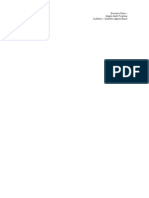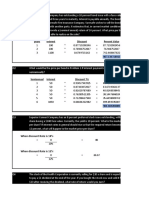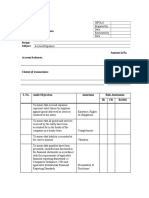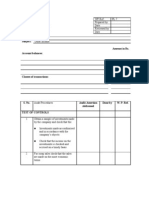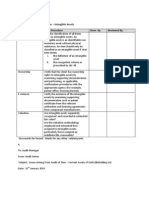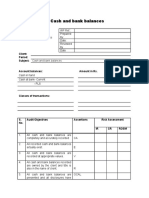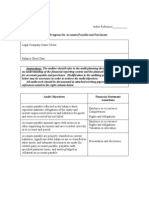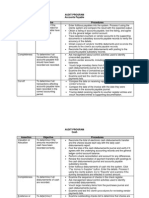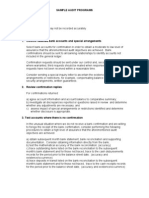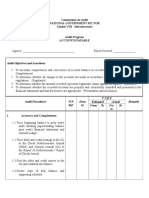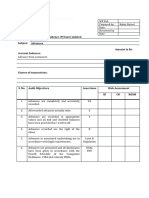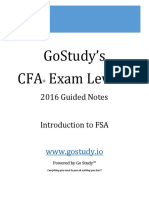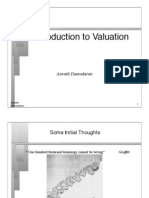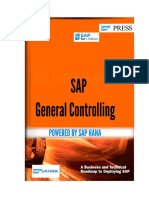Audit Program: Property Plant and Equipment
Audit Program: Property Plant and Equipment
Uploaded by
Aqib SheikhCopyright:
Available Formats
Audit Program: Property Plant and Equipment
Audit Program: Property Plant and Equipment
Uploaded by
Aqib SheikhOriginal Title
Copyright
Available Formats
Share this document
Did you find this document useful?
Is this content inappropriate?
Copyright:
Available Formats
Audit Program: Property Plant and Equipment
Audit Program: Property Plant and Equipment
Uploaded by
Aqib SheikhCopyright:
Available Formats
WP Ref.
:
Audit Program Prepared by:
Date:
Reviewed by
Date
Reviewed by
Date
Client: Ahmad Hassan Textile Mills Limited
Period: June 30, 2019
Subject: Intangible Assets
Amount in Rs.
Account balances:
Property Plant and Equipment
Intangible Assets
Classes of transactions:
Depreciation
Amortization
Loss/ gain on disposal
Impairment
S. Audit Objectives Assertions Risk Assessment
No.
IR CR CRA
1. Fixed assets are completely and
accurately recorded CA
2. All recorded fixed assets actually exist. E
3. Fixed assets are recorded at appropriate
values. V
4. Fixed assets recorded are owned by the
client and title is also in the name of
client. R
5. Depreciation /amortization / impairment
expense and gain/ loss on disposal has
been accurately calculated and
appropriately disclosed. OCATL
6. Fixed assets are presented and all
disclosures have been given in
accordance with the Fourth / Fifth
Schedules of t h e Companies Act, 2017 OCAL
and relevant IASs. RVU
S. Audit Procedures Objective Done by W. P. Ref.
No.
Test of Controls
1. Assess the reasonableness of design ALL
of system of internal control by enquiring
relevant client personnel and
documenting the same (if not a
documented system manual has been
developed by the client). A walk through
test would be necessary to confirm the
understanding as documented. Identify
the preventive (exercised before
occurrence of transactions and event)
and detective (exercised after occurrence
of transactions and event) controls
established by management to support
2. Check on sample of selected ALL
transactions covering the whole period
that all preventive controls are exercised
on all transactions.
3. Check that proper fixed assets register ALL
has been maintained and entries are
made in the register on prompt and
consistent basis and the same is
reconciled with general ledger and
physically verified assets on periodical
4. Check on a sample of transactions CE
that detective controls are appropriately
been exercised and in case of any
detection of error/ fraud, proper steps
have been taken to avoid recurrence of
5. Ensure that management does
not override the designed
controls by:
Enquiring from the designated staff
person
Remain skeptical during performing
test of design and test of effective
6. Document the conclusion after N/A
performing test of controls and required
level of assurance from substantive
Analytical Procedures
1. Assess the appropriateness of U
depreciation/ amortisation method and
rate in view of the flow of economic
benefits and useful life of the assets.
S. Audit Procedures Objective Done by W. P. Ref.
No.
2. Check the reasonableness of depreciation CAL
expense by applying depreciation rate to
closing cost/ carrying value as per the
method adopted
3. Document logical commercial reasons for AU
major additions and disposal made during
the year and check whether the additions
are in accordance with the objects of the
company
4. Compare current year balances and CEA
expense with last year balances and
expenses and ensure that any significant
variation should be properly and logically
reasoned.
Test of Details
1. Obtain movement schedule of tangible CEA
and intangible fixed assets and Capital
work-in-progress both for cost,
accumulated depreciation and
impairment. Check casting and cross
casting of the schedule.
2. Trace opening balances from fixed assets CE
register, general ledger and last year’s
working papers.
3. Make a selection of fixed assets held by CEV
client at year-end and physically inspect
them to ensure that:
(a) Asset is owned and held by client.
(b) Remaining useful life appears to be
correct
(c) No new / further impairment is
needed
S. Audit Procedures Objective Done by W. P. Ref.
No.
4. For selected additions during the current CEV
period:
(a) For purchases in current year, obtain
/ see capital expenditure approvals
and vendor’s invoices.
(b) Ensure that additions to fixed assets
do not include any amount of a
nature of revenue expenditure.
(c) Ensure that where full payment has
not been made for what so ever
reason, asset is recorded at full cost
and balance has been recognized as
liability.
(d) Obtain evidence of transactions
involving property, plant and
equipment (purchases/other
additions/sales etc) by examination
of original documentation.
(a) Review the entity’s capitalization
policy and check whether the assets
are recognized as per the criteria laid
by the policy
5. For selected assets disposed of during OAL
the current period:
(a) Obtain / see disposals approval
(b) Examine documents authorizing
disposal.
(c) Examine documents supporting
amounts for which assets were sold
e.g. cash receipts
(d) Calculate gain or loss on disposal of
fixed assets
6. To check depreciation expense: OCAL
(a) Determine the reasonableness of
accounting policy and depreciation
method, rates and their consistency
with prior years.
(b) Check calculation of depreciation of
selected assets.
(c) Assess the reasonableness of
allocation to manufacturing costs,
admin cost etc.
S. Audit Procedures Objective Done by W. P. Ref.
No.
7. Ensure that none of the assets is impaired V
or the recoverable amount of an asset is
not less than its carrying amount. If the
carrying amount of an asset is more than
its recoverable amount, that same should
be reduced to recoverable amount
recognizing the reduction as impairment
loss.
Ensure that any subsequent addition
should be depreciated over remaining
useful life and not simply depreciated by
applying the depreciation rate.
8. Inspect evidence of ownership e.g. title R
deeds, contracts , vehicle registration,
property documents, machinery import
documents etc.
9. Where assets are self-constructed and
include a proportion of capitalized interest,
administrative costs or other overheads
perform tests to ensure that only
permissible amounts are included in asset
cost.
10. Make enquiries and examine lease
contracts to provide evidence that assets
acquired under finance leases or hire
purchase agreements are properly
capitalized.
11. Examine board minutes and other
correspondence looking for indications of
significant asset acquisitions, disposals or
retirements.
12. Perform procedures to obtain
corroborating evidence that the entity
actually possesses the rights associated
with assets or intangibles - e.g. that the
cash flows or economic benefits
associated with it are actually accruing to
13. the entity.
Construction Contracts; Where a valuation
is performed internally - consider the
basis on which it was done, the adequacy
of the evidence obtained to support the
valuation and the overall reasonableness
of the result.
S. Audit Procedures Objective Done by W. P. Ref.
No.
14. Construction Contracts; Site attendance
for evidence of contract work in progress
and assessment of stage of completion of
contract.
15. Construction Contracts; Examine contract
terms and agreements
16. Construction Contracts; Inspect architects'
or quantity surveyors’ certificates to
support stages of completion
17. Construction Contracts; Examine post
year end transactions and
correspondence
18. Construction Contracts; Examination,
testing or re-performance of calculations
of attributable profits/foreseeable losses
and contract balances.
19. Construction Contracts; Where contract
work is subject to valuation by internal
valuers consider the basis on which it was
done, the adequacy of the evidence
obtained to support the valuation and the
overall reasonableness of the result. Look
for evidence of realizability of values post
year end.
Where contract work is subject to
valuation by external valuers, apply
procedures on form Reliance on experts
20. D4.7.
Construction Contracts; Examination of
post year end cash receipts - as evidence
of recoverability of recorded receivables
and as an indication of potential bad
receivables.
21. Construction Contracts; Direct
confirmation of balances with third parties.
22. Ascertain the nature of each significant E
intangible asset by inquiry or reviewing
information contained in prior-year’s
working papers.
23. Ensure that all intangible assets fully EVR
comply with the definition (identifiable,
control and flow of economic benefits)
and recognition criteria of the IAS 38 i.e.
(a) Flow of economic benefits to
enterprise is expected in future, and
(b) Cost of the asset may be determined
S. Audit Procedures Objective Done by W. P. Ref.
No.
24. For selected intangibles additions during V
the year: -
(a) Approval in Board meeting
(b) Trace the recorded value to
supporting documents e.g.
independent valuation for purchases
in current year.
(c) Obtain authorization or board
minutes.
(d) Obtain evidence of transactions
involving intangibles
(purchases/other additions/sales etc)
by examination of original
documentation.
25. For selected intangible assets disposed- CEV
off during the year: -
(a) Examine supporting documents (e.g.
cash receipts).
(b) Calculate gain or loss on sale of
assets
26. Examine documents conferring rights
associated with the intangible - e.g.
contracts, licenses - to obtain evidence of
existence.
27. Determine that client's accounting policies U
for amortization are appropriate and
applied consistently. See that intangible
assets with indefinite life are subject to
impairment review.
28. For additions in leased assets during the CEKR
year, check from lease agreements that
the lease is a finance lease in substance.
29. Ensure that depreciation on leased assets OCV
is calculated on the same rates as for
owned assets.
If there is no reasonable certainty that the
lessee will obtain ownership by the end of
the lease term, the assets should be fully
depreciated over the shorter of the lease
term or its useful life.
30. For selected additions to CWIP during the E
year: -
(a) Check supporting documents like
vendors' invoices, contractor bills,
and other evidences.
(b) Check proper authorization and
approval.
S. Audit Procedures Objective Done by W. P. Ref.
No.
31. For selected transfers to fixed assets K
during the year, check contractor
certificates of completion of project and
proper approval thereof and examine the
stage of completion.
32. For items stuck-up for considerable period V
of time, inquire about its status from the
management. Compute provisions if
required and ask for management
representations.
33. In case of revalued assets ensure that V
Entire class of assets has been
revalued on periodical basis
Any asset's revaluation results in
deficit should not be adjusted
against other assets' surplus but
should be immediately charged.
Depreciation is charged on revalued
amount and remaining useful life
Revalued amount and incremental
depreciation should be transferred to
other comprehensive income
34. Ensure that closing balances as per our N/A
working paper file are in match with
general ledger.
35. Determine that disclosures have been OCAL
made in accordance with the RVU
requirements of Fourth Schedule to the
Companies Act, 2017 and the applicable
IASs.
You might also like
- Candlestick Pattern & Chart Pattern 1.0Document61 pagesCandlestick Pattern & Chart Pattern 1.0Akib khan91% (23)
- Audit Planning MemoDocument10 pagesAudit Planning MemoChyrra ALed ZuRc100% (4)
- Roche S Acquisition of GenentechDocument34 pagesRoche S Acquisition of GenentechPradipkumar UmdaleNo ratings yet
- Audit Program For Property, Plant and Equipment Agency Name: Balance Sheet DateDocument7 pagesAudit Program For Property, Plant and Equipment Agency Name: Balance Sheet DateZosimo Solano100% (5)
- Audit Program-Long Term DebtDocument11 pagesAudit Program-Long Term DebtRoemi Rivera Robedizo100% (3)
- Internal Audit Department Audit Program For Cash: Audit Scope: Audit ObjectivesDocument3 pagesInternal Audit Department Audit Program For Cash: Audit Scope: Audit ObjectivesRijo Jacob75% (4)
- Audit of The Revenue and Collection CycleDocument5 pagesAudit of The Revenue and Collection CycleLalaine ReyesNo ratings yet
- Audit Program Cash and Bank BalancesDocument4 pagesAudit Program Cash and Bank Balances구니타100% (1)
- Creating The Exit Opportunity Final (Update2.1.22)Document60 pagesCreating The Exit Opportunity Final (Update2.1.22)Sheneth Franz Reniedo PetillaNo ratings yet
- ABC Company Audit Program - Receivables Department:: 1) Analytical Procedures-GeneralDocument7 pagesABC Company Audit Program - Receivables Department:: 1) Analytical Procedures-Generalvarghese200779% (14)
- Philippine International Trading Corporation Audit ProgramDocument2 pagesPhilippine International Trading Corporation Audit ProgramNephtali Gonzaga100% (2)
- Audit Program For Liabilities Format in The PhilippinesDocument2 pagesAudit Program For Liabilities Format in The PhilippinesDeloria Delsa100% (1)
- Substantive Tests and Audit ProgramDocument35 pagesSubstantive Tests and Audit ProgramPamimoomimap Rufila100% (1)
- Chapter 10.audit ProceduresDocument43 pagesChapter 10.audit Proceduresnychan99100% (10)
- Auditing Accounts ReceivableDocument5 pagesAuditing Accounts ReceivableVivien NaigNo ratings yet
- K AP 3 Capital Work in ProgressDocument5 pagesK AP 3 Capital Work in Progresssibuna151100% (1)
- Audit Program - Fixed AssetsDocument11 pagesAudit Program - Fixed Assetshamza dosani100% (3)
- Audit ProgramDocument16 pagesAudit Programanon_806011137100% (5)
- Audit AssertionsDocument5 pagesAudit AssertionsJazzyNo ratings yet
- The Operational Auditing Handbook: Auditing Business and IT ProcessesFrom EverandThe Operational Auditing Handbook: Auditing Business and IT ProcessesRating: 4.5 out of 5 stars4.5/5 (5)
- Aafr Ias 12 Icap Past Paper With SolutionDocument17 pagesAafr Ias 12 Icap Past Paper With SolutionAqib Sheikh100% (1)
- CFAP 1 AAFR Summer 2017Document10 pagesCFAP 1 AAFR Summer 2017Aqib Sheikh0% (1)
- 09 - Cash and Bank BalancesDocument4 pages09 - Cash and Bank BalancesAqib SheikhNo ratings yet
- Strategic Financial ManagementDocument526 pagesStrategic Financial ManagementPravin Mandora100% (4)
- The Ultimate Guide To Stock ValuationDocument57 pagesThe Ultimate Guide To Stock ValuationNight Light100% (2)
- Valuation of Long Term SecuritiesDocument12 pagesValuation of Long Term SecuritiesRasab Ahmed0% (1)
- Audit Program For Fixed Assets: Form AP 35Document9 pagesAudit Program For Fixed Assets: Form AP 35Adrianna LenaNo ratings yet
- Audit Program-Fixed AssetsDocument7 pagesAudit Program-Fixed AssetsNaomiNo ratings yet
- Audit Program-Accrued ExpensesDocument10 pagesAudit Program-Accrued ExpensesPutu Adi NugrahaNo ratings yet
- Audit Program For Other IncomeDocument3 pagesAudit Program For Other IncomeCollins O.71% (7)
- Audit ProgrammesDocument63 pagesAudit ProgrammesSarah Hashem100% (1)
- Investment - Audit Program - HandoutsDocument2 pagesInvestment - Audit Program - HandoutsRoquessa Michel R. IgnaligNo ratings yet
- Gotts2BeKidding LTD SolutionsDocument3 pagesGotts2BeKidding LTD SolutionsPikinisoNo ratings yet
- Audit Program Cash and Bank BalancesDocument4 pagesAudit Program Cash and Bank BalancesGrace Unay100% (1)
- Audit of Cash On Hand and in BankDocument2 pagesAudit of Cash On Hand and in Bankdidiaen100% (1)
- AP 15 Accounts Receivable and Sales PDFDocument8 pagesAP 15 Accounts Receivable and Sales PDFDicky Affri SandyNo ratings yet
- Substantive Test of InvestmentsDocument57 pagesSubstantive Test of Investmentsjulia4razoNo ratings yet
- Revenue Cycle Audit Program Final 140810Document11 pagesRevenue Cycle Audit Program Final 140810Pushkar Deodhar100% (1)
- Cash Audit ProgramDocument7 pagesCash Audit ProgramEirene Joy VillanuevaNo ratings yet
- Audit Planning MemoDocument5 pagesAudit Planning MemoAdolph AdolfoNo ratings yet
- Ap Audit DocumentDocument7 pagesAp Audit DocumentAnna Tran100% (1)
- Audit Program Fixed AssetsDocument6 pagesAudit Program Fixed Assetsnico_pia454No ratings yet
- AP 50 Accounts Payable and PurchasesDocument6 pagesAP 50 Accounts Payable and PurchasesSyarah AnlizaNo ratings yet
- AP - Property, Plant and EquipmentDocument6 pagesAP - Property, Plant and EquipmentRhuejane Gay MaquilingNo ratings yet
- Audit Program For Inventory Legal Company Name Client: Balance Sheet DateDocument3 pagesAudit Program For Inventory Legal Company Name Client: Balance Sheet DateHannah TudioNo ratings yet
- Audit Procedures For Accounts PayableDocument3 pagesAudit Procedures For Accounts PayableSweet Emme100% (2)
- Substantive Tests of Transactions and Account Balances EditedDocument85 pagesSubstantive Tests of Transactions and Account Balances EditedPiaElemos100% (2)
- Long Term Debt ProgramDocument10 pagesLong Term Debt ProgramSyarif Muhammad Hikmatyar100% (1)
- Audit Program For Property Plant and Equipment (Grace Crop)Document5 pagesAudit Program For Property Plant and Equipment (Grace Crop)xstljvllNo ratings yet
- AUDIT PROGRAM For Cash Disbursements 2Document5 pagesAUDIT PROGRAM For Cash Disbursements 2Yvonne Granada50% (2)
- Payroll Audit ProgramsDocument6 pagesPayroll Audit ProgramsMirage100% (2)
- Investments Audit Work ProgramDocument9 pagesInvestments Audit Work ProgramIrwansyah IweNo ratings yet
- Accounts Receivable Audit ProgramDocument3 pagesAccounts Receivable Audit Programaliraz101100% (2)
- AC414 - Audit and Investigations II - Audit of Cash and Bank BalanceDocument20 pagesAC414 - Audit and Investigations II - Audit of Cash and Bank BalanceTsitsi AbigailNo ratings yet
- 10chap Audit Working Papers PDFDocument10 pages10chap Audit Working Papers PDFjezNo ratings yet
- Audit Program For InvestmentsDocument3 pagesAudit Program For Investmentsxstljvll100% (1)
- Sample Audit ProgramDocument9 pagesSample Audit Programjanyanjanyan67% (3)
- Auditing Project Sem 3Document33 pagesAuditing Project Sem 3Vivek Tiwari50% (2)
- Advances - Deposits - and - Prepayments - Audit - Program - TODDocument20 pagesAdvances - Deposits - and - Prepayments - Audit - Program - TODShohag RaihanNo ratings yet
- Aud. Program - Accounts PayableDocument6 pagesAud. Program - Accounts PayableRalph Christer MaderazoNo ratings yet
- Audit Program For Account ReceivableDocument2 pagesAudit Program For Account ReceivableJustine Ann Villegas100% (2)
- Audit Working PapersDocument15 pagesAudit Working PapersManisha Lilani100% (2)
- 1. Property, Plant & EquipmentDocument6 pages1. Property, Plant & Equipmentrizwan.rasgNo ratings yet
- 06 - Stock in TradeDocument5 pages06 - Stock in TradeAqib SheikhNo ratings yet
- 06 - Stores and SparesDocument4 pages06 - Stores and SparesAqib Sheikh100% (1)
- 2. Intangible AssetsDocument4 pages2. Intangible Assetsrizwan.rasgNo ratings yet
- Audit Program: Provision Against Long Term Deposits Against UtilitiesDocument4 pagesAudit Program: Provision Against Long Term Deposits Against UtilitiesAqib SheikhNo ratings yet
- 08 - Advances, Deposits, Prepayments and Other ReceivablesDocument4 pages08 - Advances, Deposits, Prepayments and Other ReceivablesAqib SheikhNo ratings yet
- 1a. AdvancesDocument4 pages1a. Advancesrizwan.rasgNo ratings yet
- Newsletter-October-2024Document31 pagesNewsletter-October-2024Aqib SheikhNo ratings yet
- BFD Past Paper AnalysisDocument8 pagesBFD Past Paper AnalysisAqib SheikhNo ratings yet
- Aafr Ifrs 15 Icap Past Papers With SolutionDocument10 pagesAafr Ifrs 15 Icap Past Papers With SolutionAqib Sheikh0% (1)
- Aafr Ifrs 16 Icap Past Papers With SolutionDocument8 pagesAafr Ifrs 16 Icap Past Papers With SolutionAqib SheikhNo ratings yet
- Aafr Ifrs 16 Icap Past Papers With SolutionDocument8 pagesAafr Ifrs 16 Icap Past Papers With SolutionAqib SheikhNo ratings yet
- The Institute of Chartered Accountants of PakistanDocument6 pagesThe Institute of Chartered Accountants of PakistanAqib SheikhNo ratings yet
- South Asia Pakistan Terminals Limited - Counter Tariff: Effective From 2nd July 2018Document2 pagesSouth Asia Pakistan Terminals Limited - Counter Tariff: Effective From 2nd July 2018Aqib Sheikh100% (1)
- Pakistan Stock Exchange Named Best Performing in AsiaDocument2 pagesPakistan Stock Exchange Named Best Performing in AsiaAqib SheikhNo ratings yet
- The Institute of Chartered Accountants of PakistanDocument2 pagesThe Institute of Chartered Accountants of PakistanAqib SheikhNo ratings yet
- BFD Crash Course (ICAP) - Muhammad Samie - 12-11-2021Document11 pagesBFD Crash Course (ICAP) - Muhammad Samie - 12-11-2021Aqib SheikhNo ratings yet
- The Institute of Chartered Accountants of PakistanDocument4 pagesThe Institute of Chartered Accountants of PakistanAqib SheikhNo ratings yet
- KCO-Rate-Card 2021Document13 pagesKCO-Rate-Card 2021Aqib SheikhNo ratings yet
- Institute of Chartered Accountants of PakistanDocument4 pagesInstitute of Chartered Accountants of PakistanAqib SheikhNo ratings yet
- ILO, 2020a ILO, 2020aDocument3 pagesILO, 2020a ILO, 2020aAqib SheikhNo ratings yet
- The Institute of Chartered Accountants of PakistanDocument3 pagesThe Institute of Chartered Accountants of PakistanAqib SheikhNo ratings yet
- Announcement Regarding Presentation Amp Communication Skills Course PCSC - 2Document1 pageAnnouncement Regarding Presentation Amp Communication Skills Course PCSC - 2Aqib SheikhNo ratings yet
- Audit Program: Provision Against Long Term Deposits Against UtilitiesDocument4 pagesAudit Program: Provision Against Long Term Deposits Against UtilitiesAqib SheikhNo ratings yet
- COVID 19 Pandemic Amp Pakistan Limitations and GapsDocument15 pagesCOVID 19 Pandemic Amp Pakistan Limitations and GapsAqib SheikhNo ratings yet
- 06 - Stock in TradeDocument5 pages06 - Stock in TradeAqib SheikhNo ratings yet
- 08 - Advances, Deposits, Prepayments and Other ReceivablesDocument4 pages08 - Advances, Deposits, Prepayments and Other ReceivablesAqib SheikhNo ratings yet
- Memorandums and Letters: Apply Correct Memo and Letter FormatsDocument17 pagesMemorandums and Letters: Apply Correct Memo and Letter FormatsAqib Sheikh100% (1)
- 06 - Stores and SparesDocument4 pages06 - Stores and SparesAqib Sheikh100% (1)
- 05 - Long Term Loans and AdvancesDocument5 pages05 - Long Term Loans and AdvancesAqib SheikhNo ratings yet
- Presentation On Sir Syed Ahmad Khan by YasirDocument14 pagesPresentation On Sir Syed Ahmad Khan by YasirAqib Sheikh86% (14)
- ValuationDocument7 pagesValuationSiva SankariNo ratings yet
- M. Com. I Advanced Accountancy Paper-I AllDocument134 pagesM. Com. I Advanced Accountancy Paper-I Allatuldips100% (1)
- Inventar Biblioteca-ANEVAR 2017Document32 pagesInventar Biblioteca-ANEVAR 2017ENo ratings yet
- Task 2 - Company Overview Model Answer v2Document2 pagesTask 2 - Company Overview Model Answer v2Pruthvi Shetty ShettyNo ratings yet
- GoStudy CFA L1 - Introduction To FSA PDFDocument24 pagesGoStudy CFA L1 - Introduction To FSA PDFMaria haneffNo ratings yet
- Q4 2023 Mobility Tech Report PreviewDocument10 pagesQ4 2023 Mobility Tech Report PreviewoandriichukNo ratings yet
- FIN 6060 Module 2 Worksheet - Ifeoma Anne JohnsonDocument6 pagesFIN 6060 Module 2 Worksheet - Ifeoma Anne JohnsonIFEOMA JOHNSONNo ratings yet
- Valutation by Damodaran Chapter 1Document40 pagesValutation by Damodaran Chapter 1akhil maheshwari100% (1)
- Burns Sheehan London Tech Hiring Report 2023Document41 pagesBurns Sheehan London Tech Hiring Report 2023saintanoopNo ratings yet
- Netwrk.18 MediaDocument37 pagesNetwrk.18 MediaBandaru NarendrababuNo ratings yet
- Franklin India Ultra Short Bond Fund - (No. of Segregated Portfolio in The Scheme - 1) - (Under Winding Up) $$$Document45 pagesFranklin India Ultra Short Bond Fund - (No. of Segregated Portfolio in The Scheme - 1) - (Under Winding Up) $$$Ghanshyam Kumar PandeyNo ratings yet
- AMCT Syllabus: Certificate in Financial Fundamentals For BusinessDocument2 pagesAMCT Syllabus: Certificate in Financial Fundamentals For BusinessSd HussainNo ratings yet
- AlltradingbooksDocument96 pagesAlltradingbooksantoniomuscanti00No ratings yet
- The Platform EconomyDocument14 pagesThe Platform EconomyVincyNo ratings yet
- SAP Pocessing ClassesDocument30 pagesSAP Pocessing ClassesAlessandro Lincoln100% (2)
- General ControllingDocument195 pagesGeneral ControllingAnonymous 3MMjBL5No ratings yet
- Valuation of SharesDocument15 pagesValuation of Sharesbharatipaul42No ratings yet
- FIN202 Outline Final (New)Document10 pagesFIN202 Outline Final (New)abdulsammad13690No ratings yet
- The Absolute Return Letter February 2010: If PIIGS Could FlyDocument8 pagesThe Absolute Return Letter February 2010: If PIIGS Could Flyapi-26128650No ratings yet
- Audit Procedures Interview AnswersDocument12 pagesAudit Procedures Interview AnswersJohn EdwinNo ratings yet
- Clusters Balancing Evolutionary and Constructive ForcesDocument32 pagesClusters Balancing Evolutionary and Constructive ForcesIsna PutriNo ratings yet
- Nivetha.V 531900782 ProjectDocument73 pagesNivetha.V 531900782 ProjectDeepuNo ratings yet
- 95 AFAR Final Preboard SolutionsDocument10 pages95 AFAR Final Preboard Solutions20100723No ratings yet
- Chapters 26 and 27 Principles of Economics, Fourth Edition N. Gregory MankiwDocument42 pagesChapters 26 and 27 Principles of Economics, Fourth Edition N. Gregory MankiwDao Tuan Anh100% (2)




